Aramaic Project
No. 220 to 211 - Interviews and Performances - Video List
Goto Item No. 217 | 216 | 215 | 214 | 213 | 212 | 211| Aramaic Project Number | Description | Duration | Date of recording | Place of Recording | Video |
| AP 219 | Koonammakkal Thoma Kathanar on the beauty of the Syriac language and music. Koonammakkal Thoma Kathanar in conversation with Jarly Mathew. The beauty and the relevance of the East Syriac tradition of the Syro Malabar Church See earlier interview at Aramaic Project-16 https://youtu.be/N4cFJYlqZqo Here is an excerpt from a short and sweet conversation between Jarley Mathew and Koonammakal Thoma Kathanar, an intellectual giant of the Syro Malabar Church. The topic is the greatness of the Syriac language and music that our forefathers zealously held on to for centuries and then just let them go into oblivion by the generation that lived in the second half of the twentieth century. Koonammakkal Kathnar felt the pain and took a bold step to start the Beth Aprem Nazrani Dayra, where the Syriac language and liturgy found a home. It is not clear if his vision will continue to flourish, but we are happy to document his dream in his own words. Syriac liturgy played a significant role in his attraction toward priestly ministry as a young man. He continued his interest and became a consummate scholar in the Syriac language and culture. Thoma Kathanar cherished great appreciation for the efforts of the CMI Congregation in serving the Syriac tradition of the Syro Malabar Church. The Kathanar kept the photo of three CMI luminaries on his table: Fr. John Bosco Thottakkara (aka Guru Yohand 1920-2005, Fr. Placid Podipara, 1899-1985, and Fr. Emmanuel Thelly, 1925-2015). This is the photo we see in the background. Recently, due to ill health, Thoma Kathanar retired from academic activities. We do not know the future of the Dayara. Fortunately, the Kathanar had glimpses of the emerging interest and energized conversations on the Aramaic tradition among the Syro Malabar Catholics' younger generation across the world. Thoma Kathanar was immensely happy to hear about the Aramaic Project, and granted us an extensive interview on 3 August 2014 (Aramaic Project-16 https://youtu.be/N4cFJYlqZqo). That interview has become a valuable educational resource. We wish Thoma Kathanar peace and good health in the coming years. May the good Lord reward him for his zeal for the House of the Lord. Reference: Aramaic Project-16 Joseph J. Palackal, CMI Keywords: Koonammakkal Thoma Kathanar, Beth Aprem Nazrani Dayara, Jarly Mathew. Syriac language |
5:30 | 3 August 2014. | Recorded at Beth Aprem Nazrani Dayra, Kuravilangad, Kottayam Dt., Kerala, India. |
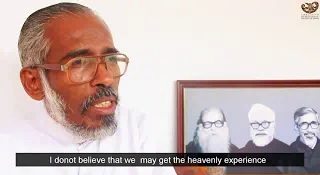
|
| AP 218 | Fr. Emmanuel Thelly, CMI, A Servant of the Syro Malabar Church, but Emmanuel Thelly, CMI (1925-2015) dedicated his life to serve the Syro Malabar Church, but the Church failed to acknowledge him. You can feel the pain in the voice of Koonammakkal Thoma Kathanar, who knew the worth of Fr. Thelly. see also Aramaic Project-1C https://youtu.be/WXM89NzLG9Y Note: Following in the footsteps of the three founding Malapans of the CMI congregation, Fr. Emmanuel Thelly CMI, dedicated his entire life to the service of the Syro Malabar Church. The SMC, however, failed to see and acknowledge the life and works of Fr. Thelly. During a videotaped conversation, Koonammakkal Thoma Kathanar, another living legend, became emotional while speaking about Fr. Thelly. According to Koonammakkal Kathanar, the services of Fr. Thelly in preserving the Syriac language in India should have caught the attention of the Government of India. Because, Fr. Thelly brought attention to the Aramaic language that is part of the cultural history of ancient India. We sincerely hope that this video will help create an informed conversation, first among the Christians in India and then the Government of India. Joseph J. Palackal, CMI |
12:00 | 3 August 2014. | Recorded at Beth Aprem Nazrani Dayra, Kuravilangad, Kottayam Dt., Kerala, India. |
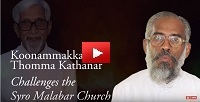 |
| AP 217 | Sunil & Seena : Bilingual Nuptial Qurbana. A historic event - 26 September 2020 Note: The conversation on the Syriac heritage of the Syro Malabar Church is taking a new momentum in North America. The inclusion of Syriac chants in a Nuptial Qurbana is an extraordinary event. It is the result of much ongoing internal dialogue in the minds of the couple and external dialogue with the extended family, the choir members, and the celebrating priests. Of course, the dialogue starts with the bride and groom. They are the ones who make the initial plans for the liturgy, months in advance. The bride and groom were confident that their family members would accept their plans. It is an indication that the awareness about the Syriac tradition that the previous generations relinquished and let go into oblivion is coming back even to the older generation. Initially, the older generation did not feel the guilt of disowning the linguistic tradition that connected their forefathers to the conversations at the Last Supper. The younger generation of Syro Malabar Catholics, it would seem, is willing to walk back in time and reclaim their identity and show to the world that they are not just children of immigrants but inheritors of a long lost legacy. The presence of a choir that learned to sing Syriac chants is an integral part of the equation. The lead singers, Jones Kalarickal, Jewel Sunny, and Jewelin Sunny are comfortable with the text and melody of Syriac chants (see Aramaic Project-100 https://youtu.be/DAvRNAOePPk). Remarkably, they sang the Creed in Syriac. This is the first time we hear the Syriac Creed during a nuptial Qurbana, or any bilingual Qurbana for that matter. It is heartwarming to hear this magnificent melody that originated in Kerala, probably by Lonappan Bhagavathar, who lived in the early part of the twentieth century at Koonammav, in the Ernakulam district of Kerala. The captivating and uplifting melody may have kept the boredom away from listening to a comparatively long chant in a foreign language. According to Tensen Kalarickal, who participated in the ceremony, the people were only appreciative of the bride and groom's decision. The history of introducing Syriac chants in the vernacular Syro Malabar liturgy in the USA goes to Saturday, 7 September 2013, at the National Shrine and Basilica of the Immaculate Conception in Washington, D. C. (see note on Aramaic Project-66 https://youtu.be/aJnk78G_bX4) About 130 young singers from across America sang in the choir. Those singers carried the message to their home parishes, and ever since, Syriac chants have been part of liturgical celebrations in English and Malayalam. Nevertheless, including Syriac chants in a nuptial Qurbana is a bold attempt. We have to wait and see how this conversation evolves into an entirely different Syro Malabar liturgy in the future. Joseph J. Palackal, CMI |
16:03 | 26 September 2020. | St. Thomas The Apostle, Syro Malabar Forane Church, Dallas, USA |
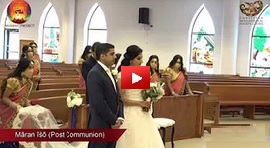 |
| AP 216 | आवून द'वशमय्या Our Father in Syriac, with Hindi transliteration and translation The Lord's Prayer in Syriac with transliteration and translation of the text in Devanagari script See more on our Encyclopedia of Syriac Chants http://www.thecmsindia.org/awun-d-was... With this video, we extent our domain to the Hindi-speaking areas in India. We hope all Christians will take pride in reciting the Lord's Prayer in the very same words that Jesus taught His disciples. This is one way to travel two thousand years back in time and imagine sitting at the feet of Jesus and listening to this prayer. The Aramaic language in which Jesus taught this prayer is not very different from the East Syriac version we hear in this video. Words and syntax are the same. The phonemes and the phonetics of the Syriac words in this chant are not alien to the Hindi language speakers. Our team has prepared the text, translation, transliteration in Devanagari, and English script translation. This is our first attempt. Suggestions from the viewers are welcome. It will be wonderful if the young generation of Syro Malabar Catholics can take up the challenge to learn the prayer and make it a part of their personal prayer. They do not require permission from the liturgical committee or the hierarchy to recite the Lord's Prayer's Syriac version. The young people can start a meaningful conversation that can eventually change the Syro Malabar liturgy's nature. We are using the track from a recording by Fr. Saji Mattathil and Fr. Joseph Pathil. We are grateful to both priests and the team that worked behind the audio CD production, THESBOHTHA. Joseph J. Palackal, CMI |
2:36 | Thesbohtha - Audio CD |
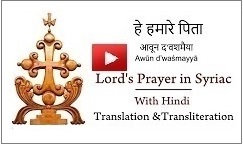 |
|
| AP 215 | Bilingual Qurbana. സുറിയാനി, മലയാളം ദ്വിഭാഷാ കുർബ്ബാന. Bp. Thomas Tharayil. Keywords #SyroMalabarQurbana #MalayalamSuriyaniQurbana #BilingualQurbana Bishop Thomas Tharayi: Bilingual Qurbana. 19 April 20. Note: Bishop Mar Thomas Tharayil, Auxiliary Bishop of the Eparchy of Changanacherry, is one of the very few bishops who feel comfortable with incorporating Syriac chants into the solemn celebration of Qurbana in Malayalam. Bishop Tharayil took the initiative to learn the language and the music. What is remarkable in this celebration is the seamless flow of prayers and chants from Syriac to Malayalam and vice versa. The chants and prayers remain in a single tonal center. The celebrant skillfully starts the slotha (prayer) on the ending pitch of the preceding chant. All these factors contribute to the experience of the entire Qurbana as a single cantata.In an earlier video, we posted the Syriac chants from this Qurbana. In this video, however, we get an experience of the logistics of a bilingual Qurbana (see Aramaic Project-201 https://youtu.be/C98-ruKKwY8). Bishop Tharayil is reversing the history of the vernacularization of liturgy in the Syro Malabar Church, starting from the early 1960s. Even after the promulgation of the Malayalam 'Thaksa', many priests continued to include a few prayers and chants, especially the Institution narrative, in Syriac. The congregation was comfortable with that approach. People had a general sense of the prayers in Syriac. Gradually, Syriac literacy became not mandatory for priests, and the new generation of priests relied entirely on the vernacular version. Bilingual Qurbana could be the next move to gradually reintroduce the sound, melody, and sentiments from the Syriac era to the present generation that did not have the privilege to know. Such a move will help the current generation to reclaim the Syriac heritage. After all, we continue to designate ourselves as SYRO Malabar Catholics. We thank Bishop Tharayil for granting permission to post this video on our channel. Joseph J. Palackal, CMI Keywords : SyroMalabarQurbana, MalayalamSuriyaniQurbana, BilingualQurbana |
1:12:03 | 19 April 20. | ArchBishop's House Chapel, Changanserry |
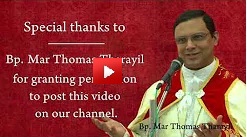 |
| AP 214 | 'ബ്ഏദാ ദ് യൗമ്മാൻ' Evelyn & Jerome Sijo Puthenpurackal, sing Marian Hymn Evelyn and Jerome sing the Marian hymn, B'eda d'yawman, recorded at their home. 14 August 2020. The conversation on the Syriac heritage of the Syro Malabar Church is catching on among those who are geographically removed from the home terrain in Kerala. Sijo and Jessin Puthenpurackal, the young parents of these children, follow the resurgence of interest in reclaiming the Syriac heritage and making it a part of the family conversations. Fortunately, the children resonate with their parents' line of thinking and make efforts to learn the text and the melody of selected Syriac chants. Interestingly, children take a liking to this Marian hymn, even though they do not understand the text's meaning. We see in the video how passionately Evelyn and Jerome sing the song. In the absence of a reference pitch, the children chose a register beyond their vocal comfort level. Nevertheless, it did not diminish their enthusiasm, nor did they falter in the melody. They have enough musicality to keep the melody in tact.Also, Evelyn and Jerome deserve admiration for learning the text correctly. We hope this video will inspire parents and children to include Syriac chants in the family conversation. We are grateful to the children's parents for granting permission to post this video on our channel and hope they will continue their interest in Syriac chants in the growing years. Joseph J. Palackal, CMI Reference: http://www.thecmsindia.org/b-e-da-d-y... Keywords : Evelyn Jerome Puthenpurackal, Kalyan Diocese Syro Malabar Mumbai, B'eda d'yawman, Syriac Chants, Christian Musicology. |
4:43 | 14 August 2020. | Residence of Sijo and Jessi Puthenpurackal |
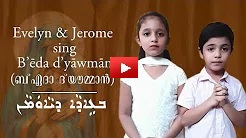 |
| AP 213 |
Dr. Zacharias Thundy recites ശ്ലാം ലേക് മറിയം Hail Mary in Syriac and Latin Zacharias P. Thundy recites the Hail Mary in the original version in Latin and the Syriac translation. A prayer from the fifth century. See more on Dr. Thundy at http://www.thecmsindia.org/personalit.... See text and translation on our Encyclopedia of Syriac Chants http://www.thecmsindia.org/slam-lek-m... Slam Lek Maryam, an endearing prayer of the Catholics around the world. The history of the prayer goes back to the Council of Ephesus (431). The focus of this Council was to establish the status of the Blessed Virgin as Mother of God (Theotokos = Carrier of God). The Syriac translation of the Greek term, theotokos, as Emme dalaha created many controversies. It was difficult for the Easterners to comprehend God as having a mother. The term, however, stayed in translation in many languages. Dr. Zach's generation grew up in Kerala reciting this prayer in Syriac. We are posting this on our channel for our viewers to hear the pronunciation of the words. We are grateful to Zach for sharing his boyhood memories regarding this chant. And we hope to get more such videos on varied topics from Dr. Thundy Joseph J. Palackal, CMINew York 22 September 2020 References: http://www.thecmsindia.org/personalit.... http://www.thecmsindia.org/slam-lek-m... Keywords: Zacharias Thundy, Slam lek Maryam, Ave Maria |
3:54 | 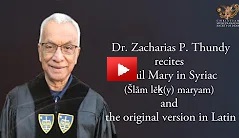 |
||
| AP 212 |
ലാക് ആലാഹ'/ദൈവമെ ഞങ്ങളങ്ങേ വാഴ്ത്തുന്നു Translation of "Te Deum" Latin Hymn Lak Alaha/Te Deum in Malayalam #ChristianMusicology #SyriacChants #ലാക്ആലാഹ http://www.thecmsindia.org/lak-alaha The history of the famous Latin chant, Te Deum ("To You O Lord), spans several centuries, many continents and cultures. The chant reached the St. Thomas Catholics in Kerala through the Portuguese missionaries in the sixteenth century. It is possible that the missionaries, who accompanied Vasco de Gama on his second trip to India in 1502, sang this hymn when they landed on the shores of Kerala, in gratitude for a safe journey. Ninety-seven years later, this hymn was part of the concluding procession at the end of the Synod of Udayamperur. Antonio Gouvea's "Jornada" (printed in 1606) provides us with a detailed description of the chant in Latin, Syriac, and Malayalam (see more details on this unique event in Palackal 2005 : 98-100). It is probable that Bishop Ros, S. J. did the Malayalam translation with the local priests' help. Eventually, the Syriac version of the chant became an essential part of priestly ordinations, jubilee celebrations, etc. In the middle of the twentieth century, the Malayalam version replaced the Syriac among the Syriac Catholics and Latin among the Roman Catholics in Kerala. We believe that Job and George duo composed the melody in a typical Kerala style in a six-beat rhythm that frequently appears in South Indian classical compositions. The video contains five related segments. The opening segment shows the performance of the Malayalam version of the chant by the CMI priests in the USA and Canada in February 2020. The occasion was the Jubilee celebration of the priestly ordination of Fr. George Manjappilly, CMI. This happened during a CMI convocation at the Immaculate Seminary at Huntington, New York. The second segment is a comment by Fr. Paulson Kannanaykkal, CMI, on the poetic meter of this text. Interestingly, he recalls a secular poem in the meter and a very similar melody. The following three segments are from our earlier recordings of the Syriac versions. We post all these segments for scholars who are interested in studying the history of this chant that covers several centuries, many continents, and cultures. Reference: Palackal, Joseph J. 2005. "Syriac Chant Traditions in South India." Ph. D. dissertation. Graduate Center of the City University of New York. Joseph J. Palackal, CMINew York 15 September 2020 |
10:19 | 14 Feb 2020 | Immaculate Conception Seminary, Huntington, New York |  |
| AP 201 |
A return to a transitional period in the history of the Syro Malabar Church. In the 1960s, when the Syro Malabar Church translated the liturgy into Malayalam, Many priests continued to incorporate specific prayers in Syriac. For many years, most of the priests recited the Institution narrative in Syriac. By doing so, they felt a connection to the Passover meal on Holy Thursday. Priests became sentimental in repeating the exact words that Jesus uttered at the Last Supper. As time went on, those sentiments diminished. The new generation of priests, who did not receive Syriac literacy training, did not share the sentiments of the older priests. Slowly and steadily, the idea of bilingual Qurbana faded, and priests and people did not miss the olden days. Fast forward to the beginning of the twenty-first century, The Syriac language and music began to get attention. The release of the audio CD, Qambel Maran: Syriac chants from South India (PAN Rcords, Netherlands 2002), and the many reviews that followed caught the attention of scholars in several countries. PAN Recorded published a second edition of the album. More importantly, the CD initiated a conversation among the Syro Malabar Catholics that led to the Indian edition. Priests, who did not have Syriac literacy, began to show interest in the Syriac melodies. Many priests experimented with incorporating the Resurrection Hymn (Laku Mara) and the Trisagion (Qandis Alaha) in the Syriac version. People seemed comfortable listening to those chants during Qurbana in Malayalam. Slowly the interest grew, and the idea of bilingual Qurbana gained acceptance, especially among the Syro Malabar Catholics in the USA. In this video, we see Mar Thomas Tharayil, Auxiliary bishop of Changanacherry, celebrating bilingual Qurbana in Malayalam and Syriac. The video shows only the Syriac portion of Qurbana. That a young bishop felt comfortable in going back to the history of the Syro Malabar liturgy is futuristic. The Bishop is creating a historic moment that will inspire other priests to attempt such experiments. That will lead to further conversations of resuscitating a language, which is an essential component of the "SYRO" Malabar Church's identity. Bishop Tharayil celebrated this Qurbana at the chapel of the Bishop's House during the COVID 19 period for homebound people. We are grateful to Bishop Tharayil for allowing us to archive this unique moment and publish it on our channel. We hope future researchers who study the Syria language's revival story will use our archive. Joseph J. Palackal, CMINew York 29 August 2020 Keywords: Bishop Thomas Tharayil. Bilingual Qurban of the Syro Malabar Church. Syriac chants, India. |
23:25 | 19 April 2020 | ArchBishop's House Chapel, Changanserry | 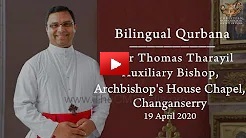 |



